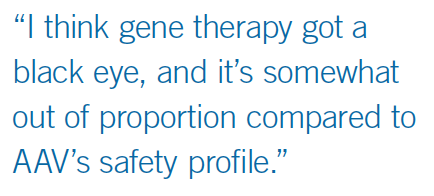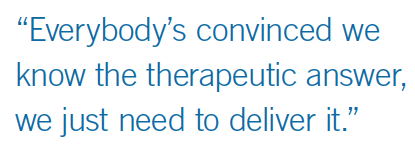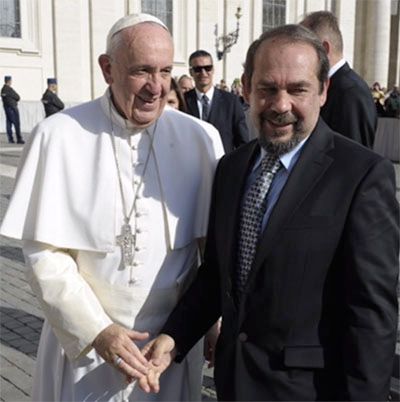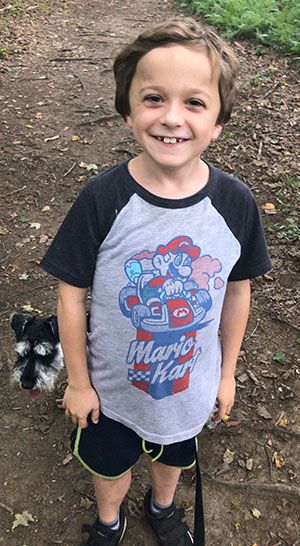R. Jude Samulski: Gene Therapy’s Guiding Force
Pharmaceutical Executive
Pharm Exec chronicles the journey of gene therapy visionary R. Jude Samulski, whose work unraveling the mysteries of adeno-associated virus continues to fuel new hopes in transforming drugs for rare disease.
A Voyage Above and Beyond: Chronicling the career “trek” of gene therapy visionary R. Jude Samulski, whose work uncovering the mysteries of adeno-associated virus while navigating the field’s reputational turbulence continues to fuel new hopes for AAV vector technology in transforming therapies for rare disease
It isn’t every day that a TV show helps change the world. But in the case of Dr. R. Jude Samulski, chief scientific officer and co-founder of Asklepios BioPharmaceutical (AskBio), one certainly provided inspiration. Samulski, a pioneer in gene therapy, grew up watching Star Trek. He was fascinated by sci-fi
Dr. R. Jude Samulski, chief scientific officer and co-founder of AskBio.

and dreamed of achieving the impossible.
That’s essentially what Samulski is doing these days-providing hope to people who thought they didn’t have a chance. After years of studying molecular virology in the lab, he co-founded AskBio, a biotech focused on adeno-associated virus (AAV) gene therapy. Today, he holds more than 200 patents related to AAV technology, and his discoveries and dedication continue to propel the field.
Nose to the grindstone
As a graduate student at the University of Florida, Samulski worked in the lab of Dr. Nick Muzyczka. Muzyczka was interested in designing viral vectors to deliver functional genes to patients who lacked them. At that time, genetic researchers everywhere were testing various viruses, such as adenovirus and retroviruses, to turn into vectors.
“I was of the generation of Star Trek and ‘to go where no man’s gone before,’ so I was totally intoxicated on the concept,” he says. “It’s like moon walk–type stuff.”
Muzyczka, Samulski, and the team were guided toward AAV by Ken Berns, the university’s then- chairman. Berns had spent his career studying the virus, which demonstrated some attractive features.
“It was considered non-pathogenic and not causing any disease in man, and yet it was a virus that infected man,” says Samulski.
There was little known about AAV, however, so the team worked from the ground up. In 1984, Samulski cloned the virus DNA into a bacterial plasmid. It was the experiment that propelled many labs to recognize the potential of AAV. It also formed the foundation for the two current FDA-approved AAV gene therapies and for most that are in development today.
“[It was] the perfect vector because you can grow it in a bioreactor, in a very controlled setting with adenovirus, and then isolate it and put it in another very specific setting, like in the brain of a diseased individual, and it will deliver that payload as if it’s its own payload. And then it’ll go latent, which means it will persist for the life of the cell,” says Samulski. “It was a unique molecular hitchhiker, since it did not cause disease like adenovirus, retroviruses, lentiviruses, herpes, and the others that were being looked at as vectors. We didn’t have to spend any energy trying to uncouple the negative things about the virus from the positive things that we wanted to utilize, which was the latency aspect of the life cycle.”
One of Samulski’s greatest milestones occurred in 1996, when his team was able to prove AAV worked as predicted. Their experiment showed that after a year and a half, the virus-delivered gene was still being expressed. Until then, every other vector trying the same experiment would fail after two to four weeks, when the immune system started attacking the foreign protein.
“Dr. Xiao [Xiao, a co-founder of AskBio,] and I were ecstatic,” says Samulski. “That was our eureka moment where we said, ‘This is different. It’s not eliciting an immune response. It’s somehow flying under the radar. It’s keeping the immune system from attacking the new gene.’”
After that, researchers started leaving adenovirus and retroviruses and began working with AAV. “It was a conversion. It was like a religion. It went viral-no pun intended,” says Samulski. “There was just such compelling data starting to show up. With AAV, if you put it in the brain or the eye or the muscle or the liver, everybody was getting results that were consistent with [our] first in vivo experiment. The Holy Grail at that point was looking for something that would deliver a gene and avoid the immune system of seeking out and destroying the gene product.”
Adenovirus vs. AAV
Though the science clearly demonstrated the difference between adenovirus and AAV, the nomenclature still produced confusion. This was clear in the aftermath of the death of Jesse Gelsinger, the first patient whose death was linked to gene therapy.
Gelsinger, 18, suffered from a genetic disease known as ornithine transcarbamylase deficiency syndrome, which

he controlled with medication. He didn’t have to undergo gene therapy but rather volunteered as a way to help other kids. In 1999, he joined a clinical trial at the University of Pennsylvania. Within four days of receiving the injection, which used adenovirus as a vector, he passed away.
“That unfortunate event was caused by adenovirus, and a lot of lay people cannot distinguish between adenovirus and adeno-associated virus, so we got thrown into the same paddy wagon,” says Samulski. “I think gene therapy got a black eye, and it’s somewhat out of proportion compared to AAV’s safety profile. Many people have died as part of experimental protocol[s]. Although tragic, it dwarfs in comparison to what happened with the development of other therapeutics that people accept readily now-bone marrow transplant, organ transplant.”
Charting a new course
That blow to gene therapy caused many investigators to re-evaluate their dedication to the field. “There was a purging of the type of science that was being done,” says Samulski. “As a result, what emerged at the other end was high-quality science that’s now translating into success in the clinic.”
Researchers originally cloned AAV2 because it was prevalent in humans-about 40% of people have an immune response that would fight it because they have already been exposed. AAV2 is just one of many forms of AAV; scientists serologically call the viruses AAV1, AAV2, AAV3, etc., based on how each AAV variant reacts to the immune response.
Researchers in Samulski’s lab also discovered they could package the same gene into each of the serotypes that existed at the time. This breakthrough was called cross-packaging.
“What you essentially were doing was developing a Rolodex of capsids that would have different zip codes on them,” says Samulski. “Then you could evaluate them one by one and see if the zip code for AAV4 would go to the lung, and the zip code for AAV8 would go to the liver. We were able to develop the technology that lets you [cross-package] the AAV genome into multiple capsid candidates.”
This opened the door from AAV2 to virtually everything that’s been developed since, including AAV7, AAV8, and AAV9, discovered by researchers at UPenn.
Though new vector discoveries are proliferating, only two are approved by FDA: AAV2, for treating retinal blindness with Luxturna, and AAV9, which targets spinal muscular atrophy with Zolgensma. Both drugs are directly related to technology developed by AskBio. Luxturna employs the company’s original AAV2 vector,

while Zolgensma uses self-complementary AAV, which means that once it is in the cell, it is functional for expressing the therapeutic.
A challenge remains in how to efficiently deliver the right drug to the right tissue. AskBio is working on delivery systems to muscle, liver, brain, lung, and heart. “What we had was a platform, and we were able to develop many different variations of delivery systems,” says Samulski. “That’s where the excitement is at the moment, because everybody’s convinced we know the therapeutic answer, we just need to deliver it.”
Partnering for progress
While many research projects find their footing with help from big pharma and venture capital, Samulski discovered a different source of support.
“We went to the Muscular Dystrophy Association (MDA) with data and an idea,” he says. “We proposed that if we could get funding, then we could try to put the dystrophin gene…back into [children with Duchenne muscular dystrophy (DMD)]. They said, ‘Jude, we’re tired of funding academic research, because the bottom line is they publish a paper and nothing ever turns into a drug for our kids. If you were a for-profit structure, so that after you developed it, it would continue to go down the pipeline, we would be interested in supporting it.’”
So Samulski created the first for-profit structure ever to be funded by the MDA. During that process, another source of support emerged.
Tripp DuPerier, the father of a son with muscular dystrophy offered $3 million, no questions asked, to help families avoid going through what his family had endured. After that, a few more parents approached the team, having learned the researchers might be their child’s only chance.
“[Our] companies were basically started by parents,” says Samulski. “We took the stewardship of taking their diseases and trying to develop therapies for them. And when we were doing this, with the explicit mission that the parents needed something for their kids, it was driven by the passion or the urgency of, ‘we need to make this happen.’”
During that time, the team was able to prove the technology worked and was safe, but ultimately, they were not drug makers. They didn’t have the resources or the manpower to take it to the next level.
“We were developers and innovators and researchers,” says Samulski. “We felt very strong that we had to partner with big pharma, who knew how to develop drugs, so that they could take the baton and cross the finish line with a product that would actually get back to the patients.”
Past successes were seen with AskBio incubator spin-off companies, including Chatham Therapeutics, for hemophilia, and Bamboo Therapeutics, for diseases including giant axonal neuropathy, Canavan disease, Friedreich’s ataxia, and DMD.
AskBio currently has a therapeutic in clinical trials for Pompe disease, and treatments for other forms of muscular dystrophy are expected to begin clinical trials in the first half of 2020. The company also is developing therapies for Huntington’s disease, epilepsy, and congestive heart failure, as well as for Parkinson’s disease with its affiliate Brain Neurotherapy Bio.
In 2016, Bamboo Therapeutics was acquired by Pfizer. In order to make good on his promise to the MDA and the DuPerier family, Samulski took a sabbatical and went to work with Pfizer as VP of gene therapy, to ensure that they could get their work into the clinic. “The data that’s been reported has been positive,” he says. “I think [the drug] is on a trajectory to be approved by the FDA.”
Samulski’s experience working with FDA has been encouraging. He is appreciative of the support and guidance it has provided to the gene therapy community. In return, he is happy to work with the agency as a consultant.
“The FDA has and continues to be the best collaborative partner the gene therapy community has out there,” says Samulski. “They went from pre-IND (investigational new drug) to pre-pre-IND, which was basically, ‘don’t wait till you have your package to talk to us, come talk to us before you have your package and we’ll give you guidance.’ That’s unheard of. And they have participated in all the meetings. They show up, they give input.”
Defining success
Samulski and Muzyczka received the first US patent of non-AAV genes inserted into AAV. In 2008, Samulski was honored by the American Society of Cell and Gene Therapy with its first lifetime achievement
R. Jude Samulski with Pope Francis at the Vatican in 2016.

award. He met China’s Minister of Health in 2009 to discuss how to bring this new molecular medicine to that nation. He also received an invitation from the Vatican in 2016, for his work in Canavan disease. But Samulski’s greatest achievement is a one-sentence letter written by a boy named Conner Curran, the first DMD patient he worked with.
“He was going to the third grade, and his teachers said their first assignment was to write the most important thing that happened to them from second grade to third grade,” he says. “All of them were writing things like I got a new bookbag, and his comment was, I’m proud that I can run faster.”
This hits home for Samulski, having kids of his own. He has framed the handwritten piece of paper and cherishes it.
“There’s no dividend that yields what you can get from that,” says Samulski. “You can’t explain it to someone. You have to experience it. If you experience it, it’s something that’s solemn and it’s subtle, and yet it shakes the earth. It shakes you to your core. It is the moment that made everything I was doing for the past 40 years come to fruition.”
Samulski continues to receive frequent updates from Conner’s mother, describing how gene therapy has

The letter written by Conner Curran (right), a Duchenne muscular dystrophy patient.

affected her son’s life. In one text she wrote: “My heart is so happy that he has more friends now and doesn’t stand around like he did before you came along, Jude. You are giving him the childhood he was missing out on.”
Shooting for the moon
When Samulski looks toward the future, he sees gene therapy becoming commonplace. While the field currently tackles many orphan diseases, gene therapy may one day treat more widespread issues, such as cholesterol. Age-related issues, such as muscle tone and memory, could also be targets. “We’ll become accustomed to it, and it won’t be as dramatic; it will lose its pizzazz,” he says. “Envision a day where someone’s going to say, Oh yeah, I was born with CF (cystic fibrosis), but I got gene therapy when I was a baby-and the [procedures are] like vaccinations.”
While it may be difficult to see that far ahead, Samulski’s unwavering belief in gene therapy is clear and confident. He and his colleagues at AskBio are not only advancing therapeutics into clinical trials, but they’re developing groundbreaking technologies that will lower the cost of goods and increase access for patients in need around the world.
“This technology is going to work,” he says. “It will be on the backs of the patients that had these rare diseases that the same technology will be used for the more widespread diseases like obesity, heart disease, Alzheimer’s, Parkinson’s, in some form. And it will get refined to where it’s like the medicines that you’re familiar with today-just viewed as another one, nothing novel.”
Elaine Quilici is Pharm Exec’s Senior Editor. She can be reached at equilici@mmhgroup.com
